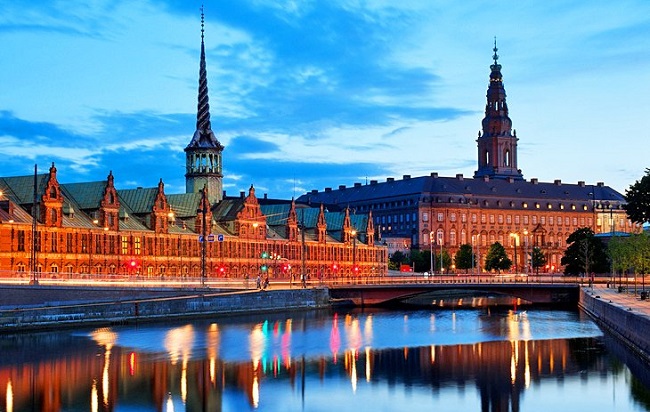Copenhagen, the country’s capital, is also its largest city. A wide variety of sights and activities await visitors of all tastes in this area. For example, the Royal Family’s official palace at Amalienborg and the Parliament (Folketing) in Christiansborg are not to be missed.
What You Want to Know?
Top 10 Places to Visit in Copenhagen
Copenhagen is arguably the most laid-back capital in Scandinavia, thanks to its charming European atmosphere, welcoming locals, and exciting café culture. You can take your time exploring the city on foot, or you can do as the locals do and ride a bike around town.

The city’s maritime atmosphere is mirrored in the bright waterfront residences of Nyhavn and the majestic tall ships moored along the quays. Don’t forget that this is widely regarded as the starting point of the Nordic food revolution.
This has resulted in a plethora of innovative dining options in the city, such as the world-famous Noma, where patrons must make reservations months, if not years, in advance. Read on for some suggestions on what to see and do in Copenhagen so you can make the most of your time in this enchanted city.
Read Also:
1. Tivoli Gardens
From Town Hall Square, cross H.C. Andersens Boulevard and you’ll arrive to the famed Tivoli amusement park and pleasure gardens, which opened in 1843 and served as the inspiration for the Disney theme parks.
The impressive entryway on Vesterbrogade cannot be missed. An impressive gateway, framed by columns, welcomes guests. Tivoli is always in the spirit of celebration. You may stroll through a village of quaint stores and a lake with beautifully lighted trees that are peacefully reflected in the water without ever leaving the gardens.
This tiny amusement park brings out the child in everyone who visits, so that quiet spot is probably as quiet as it gets.
In addition to the roller coaster, roundabouts, halls of mirrors, pantomime, puppet, and open-air theatres, plenty of restaurants and cafés, flower gardens, and a concert hall designed in the Moorish style, which looks especially nice when illuminated at night, can be found here.
Many films have featured the park’s iconic landscape. Some would even argue that it is the most well-known landmark in all of Copenhagen. Tivoli transforms into a holiday wonderland with elaborate decorations every year. Vesterbrogade 3, Copenhagen, Denmark.
2. Christiansborg Palace
The Danish capital, Slotsholmen, is located on a tiny island and is a must-see for any tourist. The Parliament, the Prime Minister’s Office, and the Supreme Court are all located in the historic Christiansborg Palace, which dates back more than 800 years.
The Royal Family still resides in a few areas, although the public is allowed access to many. Bishop Absalon constructed the city’s first defences in 1167, and the ruins of his castle and the mediaeval fortress were uncovered during the construction of the current palace, both of which are now open to the public.
The palace also features a chapel, stables, reception halls, and a kitchen fit for a king. Because different parts of the palace are used at different times, it’s important to plan ahead if you want to see a certain part of the palace. Christiansborg Slotsplads in Copenhagen is the location in question.
3. National Museum of Denmark
If you’re interested in Danish history and culture, the National Museum (Nationalmuseet) is only a 10-minute stroll along Vestergade from Tivoli. An ancient sun chariot (a cult object in the form of a cart) dates back more than 2,000 years to the Danish history collection, which also features remarkable runic stones, Romanesque and Gothic church fittings, Danish porcelain and silver, and collections of antiquities and coins.
With artefacts from Greenland, the museum’s ethnographic collection paints a vivid picture of the Inuit people’s way of life. The Indian culture, along with those of Asia, Africa, and Oceania, is only one of many fascinating subcultures represented here.
Not only that! The Prince’s Palace, built in 1744, is a Rococo structure with French Rococo influences. Go about five minutes from the National Museum to see outstanding works by this well-known Danish sculptor at Thorvaldsen’s Museum. In Copenhagen, at No. 10 Ny Vestergade.
4. The National Gallery of Denmark (Statens Museum for Kunst), Copenhagen
Danish and international masterpieces from the 1700s to the present day are on show at the National Gallery of Denmark. The 150-year survey of Danish and Scandinavian art, as well as works by the Dutch Masters, Edvard Munch, and Pablo Picasso, are among the highlights.
The upper floors of the gallery are bathed in natural light, creating a bright and spacious atmosphere. If you want to see everything the museum has to offer, it’s a good idea to get a map first. Take a rest at the museum’s café after viewing the exhibits. It’s a lovely spot, perfect for taking it easy and enjoying the scenery. Copenhagen address: 48-50 Solvgade.
5. Nyhavn Harbor
Nyhavn (New Harbor) is located behind Amalienborg and is accompanied by Nyhavn Street. In the warmer months, this charming locale becomes a bustling centre of activity.
The canal is lined with brightly painted gabled buildings, bringing a welcome dash of colour to otherwise dreary days and inviting passersby to explore the area’s shops, restaurants, and cafes.
An anchor stands at the mouth of the port as a tribute to the Danish sailors who died during WWII. Formerly a seedy neighbourhood, Nyhavn is today a picturesque waterfront district that frequently appears in photographs of Copenhagen because to its regal atmosphere.
Museum ships, including a lightship (Fyrskib) built in 1885, are anchored peacefully. Hydrofoil and catamaran services to Sweden as well as harbour and canal tours depart from Nyhavn.
6. Den Bla Planet
Den Bla Planet, also known as the National Aquarium of Denmark, was designed to look like a whirlpool from above. You dig that, right? Go inside to be even more impressed by the aquarium’s interior.
Den Bla Planet, the largest aquarium in Northern Europe, is a must-see in Copenhagen. The building’s aluminium skin conjures images of crashing waves, and the aquarium’s interior walkways branch out like tributaries from a central hub.
Around fifty aquariums and other installations containing a wide variety of marine life, from eagle rays and turtles to hammerhead sharks and seahorses, moray eels and even alligators, line these walkways. There is a wide variety of animals to observe.
Inspiring sights await you here, whether you’re wanting to see ocean animals up close or are interested in the marine life that calls tropical rivers and lakes home. Visit the café after you’ve watched the otters play or touched a tropical creature in the touch pool. Copenhagen, Postal Zip Code 2770, Kastrup.
7. The Round Tower (Rundetårn)
The Round Tower (Rundetrn) stands tall on Kbmagergade at 36 metres. It was constructed in 1642 as an observatory. A minor collection related to the well-known Danish astronomer Tycho Brahe is now housed there as well.
The platform itself is a delightful bonus, and it may be reached by a large spiral ramp. The views of the city below are breathtaking from up here. The new glass floor, which is suspended 25 metres above the ground, allows visitors to look down into the very heart of the castle.
Anyone familiar with Hans Christian Andersen’s The Tinderbox will recognise the tower from the line “eyes as huge as the Round Tower.” Why not continue on after taking in the sights and catching your breath with a little stroll through the Old Town?
Explore one of Copenhagen’s most endearing squares, Grbrdretorv, with its vividly coloured historic houses, by means of Skindergade and Kejsergade. Postal Code and Address: 52A Kbmagergade, Copenhagen.
8. Amalienborg Castle
Amalienborg, Rosenborg’s sister palace, and its tranquil waterfront grounds are located less than 1.5 km away in the Frederiksstaden neighbourhood. After the devastating fire that destroyed Christiansborg in 1794, the royal family moved into the four palaces that front onto the square.
The location once housed Queen Sophie Amalie’s lavish summer residence, which like the palace, was destroyed in a fire in 1689. The area was planned to resemble a prototypical civilization, with the King as its centre and the nobility (represented by the four palaces) radiating outward from it.
The royal family currently resides at the Christian IX Palace’s top level, while the Moltke Palace is put to official usage. The bearskin hats and blue (or red, white, and blue on certain occasions) uniforms of the Royal Guard are a distinctive symbol of the city. Copenhagen, Amalienborg Slotsplad.
9. Strøget Shopping Mile
About five minutes’ walk from Christiansborg will bring you to the heart of the city’s shopping and dining district, Strget. Between Town Hall Square (Rdhuspladsen) to Kongens Nytorv, Strget (a term from the 1800s) consists of many roads that crisscross one another. Some of the northern streets adjacent to this one are now pedestrian-only as well.
Anyone looking towards Kongens Nytorv from the end of the street will find a concentration of high-end international fashion houses like Max Mara, Prada, Louis Vuitton, and Hermès. To find more budget-friendly stores like H&M, Weekday, and Zara, head along Strget towards City Hall Square.
Read Also:
- Top 10 Places to Visit in Dublin
- Top 10 Places to Visit in Mexico City
- Top 10 Places to Visit in Washington, D.C.
10. Rosenborg Palace
This castle, originally constructed by Christian IV as a pleasure palace, is located less than 10 minutes from the Round Tower and now houses some of Denmark’s greatest cultural treasures.
The castle and its furnishings were turned into a museum in 1838, having previously served as a summer residence for the royal family (up to 1720). The Danish crown jewels and other royal regalia are stored underground.
The famed Rosenborg Tapestries have decorated the walls of the Rosenborg Palace in Copenhagen, Denmark, since 1693.
Other notable features include the Marble Room, a Baroque reception room, and the Knights’ Hall with the Coronation Throne (used between 1871 and 1940).
The display also features exquisite porcelain, such as the renowned Flora Danica service. Aster Voldgade 4A, Copenhagen, Denmark.


































